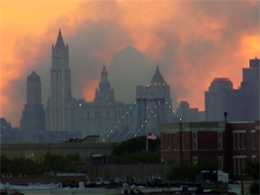Please tell me, is it safe to go home? After 9/11, science offers comfort

Rear Admiral Sven Rodenbeck, Sc.D.
The listening skills honed years earlier at a kitchen table on Long Island helped Rear Admiral Sven Rodenbeck, Sc.D., recognize the comfort his science could offer the people of Lower Manhattan following 9/11.
On September 11, 2001, the collapse of the World Trade Center's twin towers created a thick cloud of dust that blanketed the neighborhood in gray. "The environmental sampling being done was outside on the streets. But, anyone who lived there knew that a fine coat of grime seeped into apartments of Lower Manhattan," Rodenbeck explained.
"There was so much to attend to for the nation–our security, getting Wall Street back up and running–it was understandable that the response didn't immediately focus on indoor living conditions," he explained.
But there was a group of scientists poised to hear the community's plea to answer whether it was safe to return to living in their apartments. "ATSDR [CDC's Agency for Toxic Substances and Disease Registry] was experienced in hearing community concerns about environmental health and responding. It was a natural fit for us to look into residents' concerns on in collaboration with the New York City Health Department."
Having led teams for 90 public health assessments in communities across the nation, Rodenbeck combines the analytic mind of an engineer with the empathetic ear of a counselor, an exceptional bridge between the technical and the emotional.
"Before 9/11, I remember coming to a community on Long Island where some of the citizens were highly upset about a potential cancer risk. One community leader in particular was very vocal. I sat down at his kitchen table and over a cup of coffee I listened. I simply asked, 'what questions do you want answered?' We discussed every question and I explained what we could and could not answer. Technical answers mean very little if you don't first relate on an emotional level," he said.
 Asbestos was the question on the minds of most residents in Lower Manhattan after 9/11. "There had been some outdoor sampling that did detect asbestos in pockets. People wanted to know if it was widespread and if it had seeped indoors," he explained. "People were reporting irritation in their throat. They wanted answers. Asbestos was a big concern."
Asbestos was the question on the minds of most residents in Lower Manhattan after 9/11. "There had been some outdoor sampling that did detect asbestos in pockets. People wanted to know if it was widespread and if it had seeped indoors," he explained. "People were reporting irritation in their throat. They wanted answers. Asbestos was a big concern."
When he recognized no one was systematically addressing the concern, Rodenbeck directed the sampling in the apartments and condominiums in Lower Manhattan. Less than two months after the attack, the team tested 30 residential buildings in Lower Manhattan and four others above 59th street for comparison.
Significantly, Rodenbeck's team pushed for the analysis to be done by scanning and transmission electron microscope procedures instead of the more common light microscope. "We pushed the science forward on how to analyze environmental samples. At the time, the electron microscope procedures were not the standard of practice for analyzing environmental samples," he said. The analysis using the electron microscope procedures found primarily fiberglass fibers as the irritant, not asbestos.
The light microscope could detect the presence of fibers, but it could not answer the question whether it was asbestos fibers or something else. However, the electron microscope procedures could detect the difference between asbestos and fiberglass fibers. "Asbestos versus non-asbestos was a huge consideration for residents in their clean up and health concerns," he recalled.
The analysis was shared with residents and they were encouraged to continue to conduct frequent cleaning with HEPA vacuum and wet mop methods of their apartments and condominiums. "We knew they were concerned. I'm grateful we had the expertise and resources to address their immediate concerns."
The expertise for Rodenbeck included a doctor of science degree in environmental health but it also included the vision to listen to concerns voiced by a community. The resources included an electron microscope, but it also included the wisdom found sometimes at a kitchen table.
- Page last reviewed: March 19, 2014
- Page last updated: March 19, 2014
- Content source:


 ShareCompartir
ShareCompartir